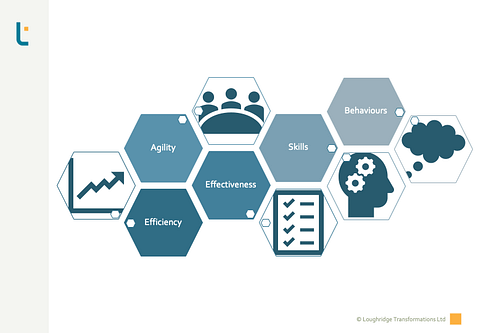Choose The Lever for Successful Finance Transformation

AUTHOR: JENNIFER LOUGHRIDGE
PRINCIPAL CONSULTANT
Jennifer is a Senior Executive Finance professional with 17+ years of global experience. She specialises in Finance Transformation and Continuous Improvement, with particular expertise in Strategy, Performance Management, Business Partnering, Commercial Decision-Making, Corporate Governance and Valuation.
jennifer.loughridge@loughridgetransformations.com
Our last post in this nine-part series looked at Define the Future – Target Setting & Benchmarking. We covered setting realistic targets and understanding “what good looks like”.
This post will focus on the fifth of the nine steps: Choose The Lever. We will look at the levers available to achieve targets. Here we are not talking about what you want to target but how you will get there. These levers will, in turn, inform your solution selection in the design phase.
The Levers – How to Make a Choice
At this point in the method, we have already looked at business strategy. Next, we have brought it down to the level of the finance function. Then, we assessed the current baseline, the starting point. Lastly, we looked at the future. With these insights, we are now ready to examine how to get there.
The absolute specifics here will vary depending on what you have determined from the four steps above. However, at Loughridge Transformations, we have distilled this into five levers.

Sometimes, you might only focus on one lever. However, if the transformation is large-scale and complex, it is more likely that you need to prioritise the levers. You use all the understanding and insight gathered at each step in making those decisions.
Let’s examine each one in more detail. We will now look at real-life examples to understand the application.

When and What?
The efficiency lever will typically appeal when your organisation’s strategic positioning is cost leadership or cost focus. There are not many organisations that are not looking for some cost savings or efficiencies. Unless the baseline assessments already demonstrate that you can operate your processes at world-class efficiency, this lever will likely feature in your scope.
It covers eliminating waste in the process and standardising, simplifying and improving processes. If digital transformation is in scope, then automation and even robotic process automation fit within this lever.
A Real-Life Solution from the Efficiency Lever: Automating the Closing
In cases where the Financial Closing process is manual and labour-intensive, you will want to look at standardising and automating, focusing on ERP-dependent tasks. It is even more relevant if your organisation has many branches across the country or has multiple global locations and, as such, has numerous “company codes” in the ERP system.
Let’s assume the Head Office is in London with company code 01; branches are in Manchester, Leeds and Glasgow with company codes 02, 03 and 04, respectively. Then, instead of running depreciation four times – one for each company code – you set a closing timetable with the step “Run Depreciation” on WD (Workday) +1 for all company codes simultaneously.
Suppose your organisation is global and cuts across continents and time zones. In that case, you may want to consider a time zone clustering of your automation — for example, a Close for Europe, Asia and the Americas.
It is worth considering that running multiple company codes in one operation would require centralising the end-to-end financial closing process, which we will cover below.

When and What?
Effectiveness will be a lever you will select when accuracy is paramount. The activities you are looking at may have a regulatory or fiscal compliance aspect. There can be other reasons you want to improve the quality of delivery.
This lever includes defining core versus non-core activities for roles, location and time-zone optimisation, and establishing centres of excellence. More generally, it will involve end-to-end process optimisation and poka-yoke – also known as error-proofing. You would also consider analytics here.
A Real-Life Solution from the Effectiveness Lever: Centralising the Closing
You will likely look for improved accuracy or “right-first-time” solutions if you have selected the effectiveness lever. That will lead you to centralise your end-to-end financial closing activities. It is critical to have the expertise and “guardians” of the close in one location or at least one location per time zone.
Whether you choose Centres of Excellence, Shared Services or Outsourcing, it will be essential to define the roles by core and non-core activities and identify the process handover points between on- and off-shore.
Your organisation may rely on process-expert roles in more complex areas like Management Information or Tax. Jobs containing these roles need to be proximate to the process execution – i.e. in the shared-service location. Otherwise, you should ensure that working hours have sufficient overlap between the two locations. If there is a lack of overlap, it will hinder two-way communication between the process expert and the execution. It will consequently also impede the effectiveness of the process.

When and What?
Here, we are not talking about Agile precisely as per the Agile Manifesto, which has its origins in software development. We do, however, mean speed, flexibility, and customer-centricity. Of course, specific activities may need this more than others, and different organisational environments will also have correspondingly different demands.
Solutions in this lever could include tools that allow end-user customisation. It might also cover processes or procedures focused on building improvements over time or where process operator discretion exists.
A Real-Life Solution from the Agility Lever: Joint-Venture Management Information
Let’s assume you are in charge of presenting Management Information reports to your joint-venture partners. There has been a strong drive towards standardising reporting in the organisation that owns and operates your joint venture. However, your joint venture requires bespoke reporting as end-user customisation is not part of the global design.
Although you may want to understand the cost implications of bespoke versus built-in customisation for end-users, it may be a wiser choice. More so if your global organisation operates several joint ventures with specific and different reporting requirements.
This example demonstrates the importance of being clear on the levers (and their priority) before solution selection. It is important because the organisation’s technology, processes and roles are all affected. In addition, there may be risk and control implications depending on the eventual use of the reports.

When and What?
People operating the steps in the process need the knowledge and skill to execute those steps efficiently and effectively. The less transactional the process step is, the more this is the case – or the more difficult it is to poka-yoke the process.
Skills, therefore, should nearly always be one of the levers. However, it can be the most critical lever depending on the scope.
Which Skills Are We Considering?
Classically, in Finance Transformation, Business Partnering will be a skill set that gets attention. However, the skills requirements can be broader depending on the functional fit. The baseline assessment will give insights into how big of a gap.
In addition to Business Partnering, Data and Analytics skills and digital skills, more comprehensively, are part of this lever. Roles in Finance are evolving, so the skills needed are also changing.
Skills like process management (and improvement), technology integration, data mining and algorithm writing join the, perhaps more expected, commercial and business acumen, business integration and collaboration and value-based strategy and execution. Once you have clearly defined the needed skills, developing existing staff and recruiting new staff is usually the solution.
A Real-Life Solution from the Skills Lever: Developing Business Partnering in a Small Team
As Finance Manager for a segment of the business in your organisation, you have recently participated in the migration of management information and analysis activities. Your organisation decides not to reduce your team’s size but instead to improve the business-partnering skills of your team to position them to interact differently with the parts of the organisation with which they work.
Skills Assessment
It is not an unfamiliar scenario, but how do you deliver on the objective? The first thing is recognising that you must address the team’s collective and individual skill levels. Your team is small, so you can decide to make the individual assessments informally together with a trusted peer to reduce any potential bias you may have. Let’s say you have determined the three critical aspects of business partnering, as it is relevant to your organisation, to be:
- commercial thinking
- business integration
- functional collaboration
Once you make your assessment, you will know which of your team members is strongest in which area and which needs further development. You will also know if there is an area where your team is weaker across the board.
Learning and Development Schedule
With these insights, you can make a learning schedule for your team. For example, you could ask some of your team members to lead a learning session on a topic where they have a particular strength. Typically, learning circles are particularly beneficial in this space, where team members can share and build on experiences. Besides, you are creating a stronger feeling of ownership of personal development. You could lead that session yourself or invite an external guest if you have a collective gap. Lastly, you can also use these insights if you do any recruitment in your team, as you will know which gaps you are explicitly trying to reduce.
You could also focus on skills development on a much larger scale via a formal programme. However, this example shows that a single team can, within their control, already make a significant difference in how they partner with the business and impact the bottom line.

When and What?
Many aspects of Finance Transformation can trigger a need to look at the Behaviours Lever. Introducing or deepening the use of Shared Service Centres or Outsourcing Partners will mean that on- and off-shore collaboration will have greater focus. It may also mean a new requirement to collaborate across cultures – whether working, cultural or geographical norms. With the introduction of an enterprise or functional process model, there will be a greater emphasis on working together across the end-to-end process. Enhanced process discipline is likely to be a component with attention to improving the process rather than working around it.
Depending on the baseline assessment outcomes, you may uncover existing team dynamics issues where you will want to understand and leverage better individual preferences. The transformation may also create brand new teams you want to give a headstart on effective working.
A Real-Life Solution from the Behaviours Lever: Process Discipline in a Non-Transactional Environment
In this example, we assume your organisation is mid- to large-scale and global. The organisation regularly makes investment or divestment decisions of material value. Your organisation has defined that as greater than 10 million USD equivalent.
The Problem Statement
Your organisation already has a written policy and procedures for the investment and divestment process. However, the process is fragmented, very decentralised and subject to local practices for supporting documentation and document retention, among other things. Consequently, inconsistent documentation is being retained in support of the investment decisions. Furthermore, there are difficulties in establishing the rationale for earlier investment decisions, as these are stored in various local data repositories with different degrees of data access security. As a result, your organisation could potentially risk unauthorised access to highly confidential documentation.
Consequently, the Internal Audit department in your organisation has flagged the issue as high risk. You are responsible for risk mitigation within a relatively short timeframe. The task might seem overwhelming, as there are many stakeholders involved globally. You know your organisation does not have the appetite to update the Investment Decision Policy. Centralising the activity is not an option as your organisation needs local business proximity. You will need to tackle this risk with behavioural change underpinned by some enablers of process discipline. However, as this example shows, the solution is simple.
Framing the Solution
As with any problem-solving activity, your first task should be to breakdown the problem into tangible parts:
- No global compliance team for the end-to-end process
- Retention of documentation is decentralised and follows local practice, and is subject to interpretation by local staff
- Requirements for supporting documentation follow local practice and are subject to interpretation by local staff
- No centralised expertise team exists from whom local staff can seek advice or clarification
There is a theme where this process has, to date, not required a lot of process discipline. Much is left to the discretion or interpretation of the process operator. Each process operator makes their best effort and consideration to “do the right thing”. Nevertheless, the result is a high volume of solutions with variable quality. How can you support and enable the organisation to have a higher level of process discipline?
Let’s assume your organisation already has a Governance, Risk & Assurance (GRA) team or a Shared Service Centre – many mid- to large-scale companies do. Either fit perfectly as guardians of this end-to-end process. To be clear – they are the guardians of the end-to-end process. The actual investment or divestment decisions are still taken by those holding that authority supported by those proximate to the business.
Detailed Design
You can then design a mandatory standard template with the identified compliance team to be used globally (following the existing policy document). A more detailed guidance document outlining each step in the new global template can be prepared. Furthermore, you implement a central data repository with appropriate access to ensure proper document retention. Lastly, you design a monthly, quarterly or bi-annual control to sample-check prior period decisions to monitor compliance effectively.
Management now has the assurance that all decisions comply with the policy, correct authorisation is in place, and adequate supporting documentation is centrally filed together with the decision documentation – all with appropriate access. As a further benefit, any pre-existing local controls can safely be de-scoped. Your new control point will now cover the global end-to-end process.
Your central GRA or Shared Service Centre team has become the end-to-end process’s guardian and custodian. They hold process expertise, while the actual decisions remain business-proximate. As a result, the risk flagged as high has been mitigated.
Conclusion
The five levers: Efficiency, Effectiveness, Agility, Skills and Behaviours, as we have demonstrated, define how you will tackle Finance Transformation. Having decided which levers apply or should be prioritised, you can make more intelligent design solution selections. You will know that it fits with the strategic positioning and functional fit and reflects your starting point – the baseline.
Interested in More Finance Transformation?
Our next post will focus on the sixth step: Understand the Context. We will look at what is going on that may be outside your control and organisational givens.
Did you miss some of the other posts in this series? Find them here:
- Finance Functional Fit: The Most Critical Scope Definition You Need
- Strategy: How to Supercharge Finance Transformation
- Reviewing the Nine Steps to Finance Transformation
- Sustain the Change: Finance Transformation to Last
- Deployment for Finance Transformation: Ensuring a Successful Go-Live
- Delivery – Design and Prepare for Robust Finance Transformation
- Finance Transformation: Understand The Context to Secure Excellence
- Choose The Lever for Successful Finance Transformation
- Define the Future – Target Setting & Benchmarking
- Baseline Definition – A Reliable Assessment Model for the Finance Function
- Nine Steps to Finance Transformation
Find Out More About Working with Loughridge Transformations
Get the Latest from Loughridge Transformations
Subscribe to Our Blog
Alternatively, take a look at our most popular blog posts:
Looking for something else? Here’s what we have been blogging about recently:
Agile Analytics Associates Automation Behaviours Building Trust Business-Partnering CFO Remit Change Management Coaching Collaboration Continuous Improvement Control Design Corporate Governance Data Deployment Design Principles Digital ERP ESG Finance Function Finance Transformation Implementation Migration Off-Shoring Organisation Organisation Design Process Process Design Process Governance Process Performance Productivity Programme Management Office Project Management Readiness Risk & Controls Skills sponsorship Standard Organisational Model Strategy Systems Systems Design Technology Transformation Virtual Working


